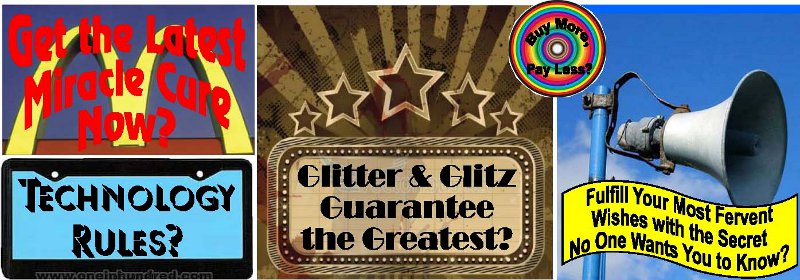Get more than you pay for! This and other often heard but rarely explained catch phrases sound great, but they frequently fail to deliver. Glamor and Guarantees too often override good sense, making it seem that the “latest & greatest” have arrived and need to be purchased at high (but “fair”) prices right now. Advertising for (electronic) “miracle cures” implies that our fervent wishes will be fulfilled—and our situational problems, solved—if we spend scarce financial resources on whatever creates the most buzz--today. The newest, expensive print material—full bright color, correlated to recent committee-set standards, reviewed by (carefully chosen) experts, and delivered with every audio/visual, online, and otherwise linked ancillary known to the technically gifted, present themselves as all that overwhelmed educators need. With these, we "should" be able reach any group of one to fifty (struggling) learners--and to help ourselves as well—successfully and effortlessly. Everything else is ignored: individual goals, purposes, teaching/learning styles, and limitations; the logistics of time, space, and conflicting interests; administrative duties and official requirements; and whatever else comes up in the real-life world of education.
Well, fellow educators, we have a different view of what really makes our lives easier, our teaching and learning more effective, and our efforts more effective and rewarding. Here are some important (but rarely offered) features of materials and techniques that have always worked for us and for those we communicate with:
1. High value at a low price to pay, which is not to imply that successful education can or should be “free of cost” to those that achieve it. Instead of money, our “investment” can consist of engagement, energy, excitement, and enhanced effort .
2. Proof of practical usability no matter what the requirements of each situation. In contrast to the flashy and fleeting, the well-tested and proven is more likely to “deliver” because it has already been used, reacted to, assessed, and revamped by many kinds of teachers and learners. The ideal is to connect value derived from the tried-and-true past to the immediate and quickly changing needs of the present and future.
3. Flexibility of use in a variety of settings, regardless of the particular subject matter or desired learning outcomes. Multi-use and multi-leveled generic materials and methods tend to be the most productive. Specific content and format deliver the most value if they can also be applied to other areas of instruction.
4. Reduction or elimination of waste—of face-to-face, networking, or alone time; of focus or energy; of space on the printed or online page; and/or of other valuable elements of processes and progress. Whether teaching or learning, reasoning or creating, performing or improving, and/or reacting to or helping others, participants ought to be productively engaged in learning or communicating nearly all the time, getting maximum benefit out of the effort they are putting in.
5. Convenience & portability, so that tools and techniques become useable and retrievable “at home” or “on the road”—in virtually any formal or casual, structured or improvised, and well-equipped or “make-do” context. Materials and methods that work can be put to immediate good use and continue to evolve indefinitely.
6. Real “customer service,” which translates to a “feel” for effective instruction; an ability to engage and motivate others; and a friendly, non-threatening eagerness to share and connect. These can best be delivered by experienced, accessible personnel familiar with one another’s goals, needs, situations, values, resources, and so on . . . .
2. Proof of practical usability no matter what the requirements of each situation. In contrast to the flashy and fleeting, the well-tested and proven is more likely to “deliver” because it has already been used, reacted to, assessed, and revamped by many kinds of teachers and learners. The ideal is to connect value derived from the tried-and-true past to the immediate and quickly changing needs of the present and future.
3. Flexibility of use in a variety of settings, regardless of the particular subject matter or desired learning outcomes. Multi-use and multi-leveled generic materials and methods tend to be the most productive. Specific content and format deliver the most value if they can also be applied to other areas of instruction.
4. Reduction or elimination of waste—of face-to-face, networking, or alone time; of focus or energy; of space on the printed or online page; and/or of other valuable elements of processes and progress. Whether teaching or learning, reasoning or creating, performing or improving, and/or reacting to or helping others, participants ought to be productively engaged in learning or communicating nearly all the time, getting maximum benefit out of the effort they are putting in.
5. Convenience & portability, so that tools and techniques become useable and retrievable “at home” or “on the road”—in virtually any formal or casual, structured or improvised, and well-equipped or “make-do” context. Materials and methods that work can be put to immediate good use and continue to evolve indefinitely.
6. Real “customer service,” which translates to a “feel” for effective instruction; an ability to engage and motivate others; and a friendly, non-threatening eagerness to share and connect. These can best be delivered by experienced, accessible personnel familiar with one another’s goals, needs, situations, values, resources, and so on . . . .
We appreciate your getting back to (or back at) us with your wishes, preferences, requirements, and requests.
For a list of titles with (many of) the above listed features, you can click here: Alphabetized Authors & Editors Product List. More information about products is available in the print or Online Authors & Editors Creative Language Teaching & Learning Catalog and at the Authors & Editors Online Store. No-cost materials can be downloaded from Teaching Tools, Tips, & Techniques--as can the Try-Before-You-Buy samples attached to product descriptions.




